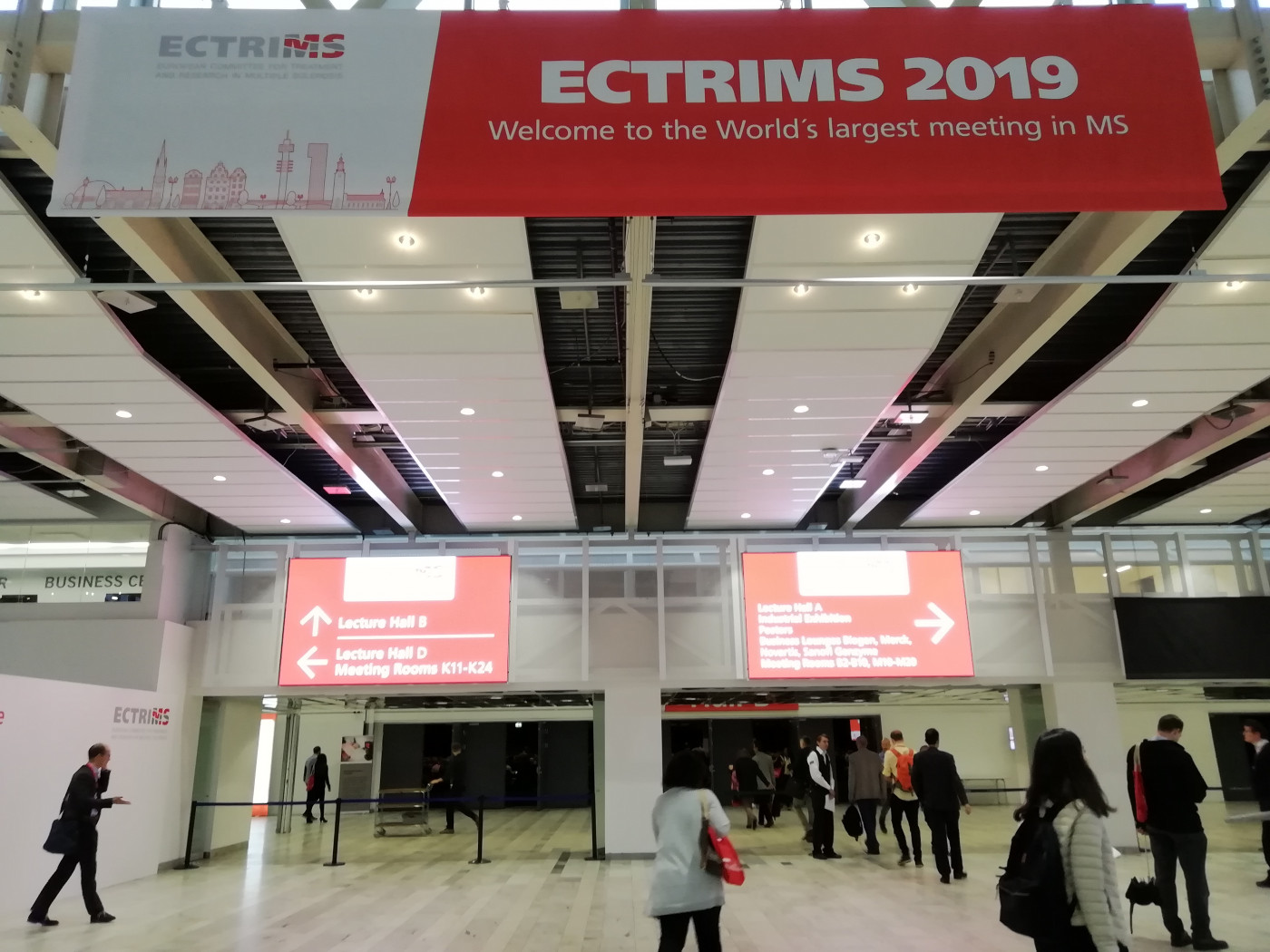#ECTRIMS2019 — Promises and Warnings About Stem Cell Therapy
Written by |

#ECTRIMS2019
Stem cell therapy, or stem cell transplant, is an emerging yet controversial treatment approach for multiple sclerosis (MS). While some data uphold it as one of the most efficacious MS treatments, to date there have been no controlled studies comparing it to conventional medicines and providing more robust evidence regarding its safety and clinical benefit.
Under the topic “HSCT and stem cell treatment in MS,” a group of researchers discussed the promise and current challenges of stem cell transplant at the 35th Congress of the European Committee for Treatment and Research in Multiple Sclerosis (ECTRIMS), being held Sept. 11–13 in Stockholm.
Several lines of research have bolstered hope for the use of adult stem cells to slow MS progression and help repair damage to the nervous system. There has been particular interest in the transplantation of hematopoietic stem cells (HSCs) — adult stem cells found in the bone marrow and blood that are capable of forming all of the cells that make up the blood and the immune system.
Research on the potential of other stem cells for MS is also underway, including mesenchymal stem cells (MSCs), and neural stem cells (NSCs).
To date, the only proven stem cell treatment for MS is autologous HSC transplant (AHSCT), particularly in people with highly active relapsing disease.
AHSCT basically consists of a bone marrow transplant where HSCs are collected from the patient (aka autologous) and given back after the immune system is partially or completely wiped out by a conditioning treatment, usually chemotherapy.
Stem cells are then expected to grow a new immune system “from scratch.” The idea is to “reprogram” the immune system in order to restore its normal function, and slow or stop the attacks to the nervous system.
Greater expectations for AHSCT have been raised after recent studies indicated that the therapy might be more successful if done in the earlier (inflammatory) stages of MS.
Despite these results, most clinicians are reluctant about the risks and the lack of data regarding AHSCT in MS patients.
On top of that, an emergent problem is worrying the medical community — some clinics around the world are selling unproven transplant therapies as a potential cure for MS, sometimes with negative health and/or financial consequences.
Growing hope for AHSCT
Joachim Burman, MD, PhD, a researcher at Uppsala University, in Sweden, made the case as to why AHSCT may be the most efficacious MS treatment so far, and why it should be made widely available. His talk was titled “HSCT for MS — we are ready for prime time.”
According to Burman, AHSCT was first used for MS in 1995, and since then more than 2,500 patients have undergone the procedure in Europe. Initially explored for hard-to-treat, progressive forms of MS, interest in AHSCT has shifted toward its use in relapsing-remitting MS (RRMS), where it has been yielding the most encouraging results.
Advantages of AHSCT include the fact that a single administration can yield prolonged benefits, with no need for alternative treatments. In addition, the majority of patients (68–70%) achieve “no evidence of disease activity” (NEDA) — no relapses, no increase in disability (as measured by EDSS), and no new or active lesions on MRI — at five years after treatment, suggesting a superior efficacy compared to conventional disease-modifying therapies (DMTs).
Yet such evidence is weakened by the lack of control groups (e.g. a comparison group with patients on routine care with DMTs) in these studies.
Safety also has been a major concern with AHSCT, particularly the fact that the intensive immunosuppressive treatment patients have to receive might be too dangerous. But, according to Burman, advances have been made in recent years to improve the safety of these procedures.
Interestingly, recent results from the trial MIST (NCT00273364) confirmed earlier promising data regarding the use of AHSCT versus DMTs in people with highly active RRMS.
Results showed that at five years of treatment, 78.5% of patients who underwent AHSCT remained in a NEDA status, while only 2.97% of those who were on DMTs achieved it. In addition, half of the patients (one in two) treated with AHSCT reduced their disability level (as measured by EDSS), whereas only one in 13 improved with DMTs.
No deaths or life-threatening adverse events occurred in the MIST study, supporting AHSCT as a safe procedure if done at accredited and experienced centers.
“At this point, it is justified to say that AHSCT is superior to standard [DMT] treatment in terms of efficacy, and it seems to be on par with other advanced therapies in terms of safety. Current evidence supports a more widespread use of this procedure,” Burman concluded.
Minding the risks
A more cautious look was upheld by Stephen Hauser, MD, professor at UCSF Weill Institute for Neurosciences, University of California, San Francisco.
In his presentation, titled “Hold your horses — HSCT is still an experimental treatment,” Hauser noted the promise of AHSCT, but also the potential disadvantages and risks that need to be taken into account.
He agreed with Burman that HSCT indeed offers some advantages, namely “high effectiveness against relapsing disease” and the fact that “a single administration only can yield a prolonged benefit lasting years,” which is “an appealing prospect for patients and payers.”
Furthermore, some studies indicate that HSCT provides some degree of “reprogramming” of the immune system, which can be important in the context of autoimmune diseases.
However, serious safety concerns, especially with more intensive conditioning (immunosuppressive) regimens, a lack of reliable long-term follow-up data, and little evidence supporting effectiveness in advanced MS cases must be considered, Hauser said.
Also, there is still uncertainty as to whether self-attacking immune T or B cells are permanently deleted with HSCT.
“We are entering an era where relapses are well-controlled in the vast majority of patients. Looking ahead, the relative value of treatment options will likely be based primarily on their effect against progression, which occurs throughout the disease course and in all forms of MS,” Hauser said.
For him, a demonstration of long-term protection against the degenerative component of MS progression will be key. Furthermore, Hauser stated that a MS cure would mean elimination of all evidence of immune autoreactivity and inflammation in the central nervous system (CNS), which, he noted, “has not yet been convincingly demonstrated with any MS therapeutic agent.”
The researcher also presented a case study of a young patient with MS, and used it to emphasize that “in a situation of clinical equipoise” between choosing a DMT or HSCT, clinicians should “subject patients to the least possible risk!”
“I think we have the obligation of exposing our patients to less possible risk — so in this case I would choose highly effective DMT,” Hauser said.
When asked what would he consider compelling evidence for the use of HSCT in routine clinical practice, Hauser said: “First, I think that the conditioning regimens used would need to be safe … even one percent of death rate is unacceptable.”
Mesenchymal stem cell therapy
In addition to AHSCT, other stem cell therapies are being studied for MS, including mesenchymal stem cell therapy (MSCT). This was the focus of the oral presentation “Mesenchymal stem cell treatment in MS“, given by Antonio Uccelli, MD, professor at the University of Genova, Italy.
MSCs are adult stem cells found in several places in the body, including the bone marrow, skin, and fat tissue. MSCs have been studied for their potential benefit in neurodegenerative diseases, because of their ability to reduce inflammation and make the immune system less active. Scientists hope these properties can tune down the auto-reactive attacks against nerve cells and boost myelin repair in MS.
Similar to AHSCT, a transplant of MSCs involves isolating these cells from the patient, multiplying them in the lab, and infusing them back into the blood or fluid surrounding the patient’s spinal cord (intrathecal injection).
Early animal studies suggested that MSCs are able to enhance tissue repair, ameliorate EAE (experimental autoimmune encephalomyelitis; a disease in a mouse model mimicking MS), promote neural repair, and influence the immune response.
A few small clinical studies in MS patients have provided early evidence that this type of transplant is safe and might be effective.
As more robust data is needed, researchers are conducting a Phase 1/2 trial called MESEMS (mesenchymal stem cells for multiple sclerosis) in MS patients to assess the safety and efficacy of MSC treatment compared to placebo. The trial is mainly focused on patients ages 18–50 with very active disease.
According to Uccelli, the team recently got preliminary data (in the end of July 2019) of the trial. Unfortunately, data showed that the trial did not meet its primary endpoint — there were no differences between MSC-treated patients and those receiving placebo at week 24 in terms of number of active lesions.
Regarding safety, “adverse events were equally distributed between groups,” Uccelli said, but “serious adverse events tended to be more common in the placebo group.”
As for the secondary endpoint — number of relapses — Uccelli said the team observed “a strong signal of a reduction of the relapse rate of about 36%” with MSC therapy, although statistical analyses are still needed to confirm the statistical significance of this result, compared to placebo.
Overall, Uccelli concluded that, although the trial did not meet its primary endpoint, it “demonstrated an important trend toward decreasing the annualized relapse rate over 24 weeks” with MSC treatment, and suggested that “analysis of secondary and exploratory outcomes will reveal whether MSC are effective on other MRI and/or clinical parameters in MS, as well as on any defined metrics suggesting repair.”
Uccelli believes that “clinical exploitation of MSC for MS may lead to novel strategies aimed at blocking uncontrolled inflammation, protecting neurons and promoting repair, but not at restoring deranged neural network responsible for irreversible disability.”





